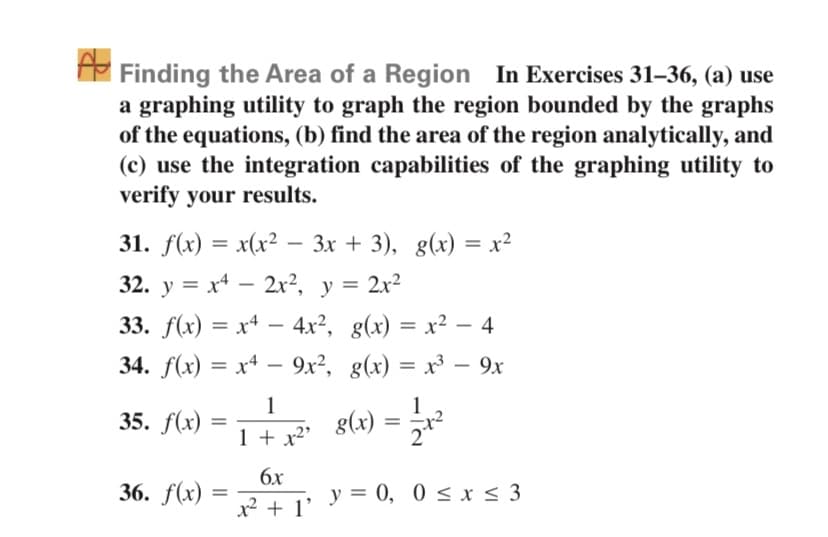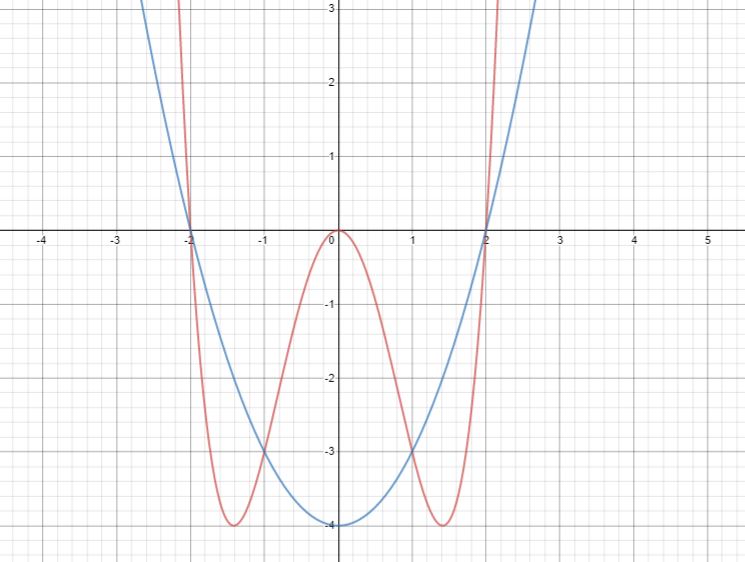Please do #33. (1)First need to draw a graph of the region — and copy it on you paper. (2) Show the algebra steps as need when (i) finding the solutions to f(x) = g(x) to get the intersection points of the two curves forming the region; and (ii) determining for EACH subregion that, which curve is the top boundary and which one is the bottom (that is checking if f(x) is greater or g(x) is greater). (3) Set up integral(s) to calculate the area of each region
Please do #33. (1)First need to draw a graph of the region — and copy it on you paper. (2) Show the algebra steps as need when (i) finding the solutions to f(x) = g(x) to get the intersection points of the two curves forming the region; and (ii) determining for EACH subregion that, which curve is the top boundary and which one is the bottom (that is checking if f(x) is greater or g(x) is greater). (3) Set up integral(s) to calculate the area of each region
Calculus: Early Transcendentals
8th Edition
ISBN:9781285741550
Author:James Stewart
Publisher:James Stewart
Chapter1: Functions And Models
Section: Chapter Questions
Problem 1RCC: (a) What is a function? What are its domain and range? (b) What is the graph of a function? (c) How...
Related questions
Question
Please do #33.
(1)First need to draw a graph of the region — and copy it on you paper.
(2) Show the algebra steps as need when (i) finding the solutions to f(x) = g(x) to get
the intersection points of the two curves forming the region; and (ii) determining for EACH
subregion that, which curve is the top boundary and which one is the bottom (that is
checking if f(x) is greater or g(x) is greater).
(3) Set up integral (s) to calculate the area of each region.

Transcribed Image Text:E Finding the Area of a Region In Exercises 31–36, (a) use
a graphing utility to graph the region bounded by the graphs
of the equations, (b) find the area of the region analytically, and
(c) use the integration capabilities of the graphing utility to
verify your results.
31. f(x) — x(x? - 3х + 3), g(x) — х?
32. y = x* – 2x², y = 2x²
33. f(x) = x4 – 4.x², g(x) = x² – 4
-
34. f(x) = x+ – 9x², g(x) = x³ – 9x
%3D
%3D
1
35. f(x)
1
g(x)
1 + x²'
6x
36. f(x) =
x2 + 1' y = 0, 0 < x< 3
Expert Solution
Step 1
Solution Q 33
Given,
Step 2
First finding the point of intersection
x4 - 5x2 + 4 = 0
Let's assume t = x2 and t2 = x4
t2 - 5t + 4 = 0
t2 - 4t - t + 4 = 0
t(t-4)-1(t-4) = 0
(t-4)(t-1) = 0
t = 1 and t = 4
then
x2 = 1 then x =
x2 = 4 then x =
Step 3
Now sketching the graph of both the curve
Red curve represents
blue curve represents

Step by step
Solved in 5 steps with 1 images

Knowledge Booster
Learn more about
Need a deep-dive on the concept behind this application? Look no further. Learn more about this topic, calculus and related others by exploring similar questions and additional content below.Recommended textbooks for you

Calculus: Early Transcendentals
Calculus
ISBN:
9781285741550
Author:
James Stewart
Publisher:
Cengage Learning

Thomas' Calculus (14th Edition)
Calculus
ISBN:
9780134438986
Author:
Joel R. Hass, Christopher E. Heil, Maurice D. Weir
Publisher:
PEARSON

Calculus: Early Transcendentals (3rd Edition)
Calculus
ISBN:
9780134763644
Author:
William L. Briggs, Lyle Cochran, Bernard Gillett, Eric Schulz
Publisher:
PEARSON

Calculus: Early Transcendentals
Calculus
ISBN:
9781285741550
Author:
James Stewart
Publisher:
Cengage Learning

Thomas' Calculus (14th Edition)
Calculus
ISBN:
9780134438986
Author:
Joel R. Hass, Christopher E. Heil, Maurice D. Weir
Publisher:
PEARSON

Calculus: Early Transcendentals (3rd Edition)
Calculus
ISBN:
9780134763644
Author:
William L. Briggs, Lyle Cochran, Bernard Gillett, Eric Schulz
Publisher:
PEARSON

Calculus: Early Transcendentals
Calculus
ISBN:
9781319050740
Author:
Jon Rogawski, Colin Adams, Robert Franzosa
Publisher:
W. H. Freeman


Calculus: Early Transcendental Functions
Calculus
ISBN:
9781337552516
Author:
Ron Larson, Bruce H. Edwards
Publisher:
Cengage Learning